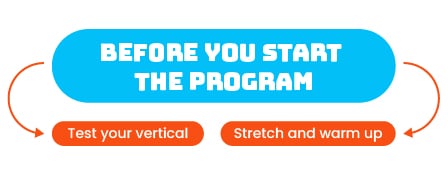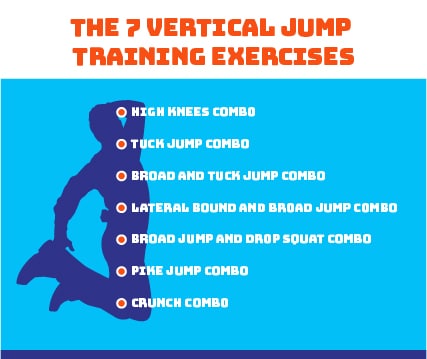
The key to the successful completion of the Best Vertical Jump Programs is to follow the instructions. There are no shortcuts with the program we recommend in this blog and there should not be any shortcuts taken for any other Workouts To Increase Your Vertical.
For the duration of the program we recommend in this blog, you do not need to - and should not - change the patterns for the workouts. Stick to the regimen we have drafted for you. You must not change the number of sets for the exercises that you conduct, week-on-week either.
There are programs out there that will suggest changing patterns and sets of exercises but that can be counterproductive, as it has an adverse impact on your capacity to grasp the right technique.
When performing any jump training regimen, it is more important to master the technique and adopt the correct form.
It is also important to promote some muscle memory during the course of your workout programs - chopping and changing from one week until the next will do more harm than good in that respect too. Repetition has been proven to lead to greater levels of success in athletic performance.
Remember that the quality of your training is always more important than the quantity of said training. Less is more with vertical jump training.
With all programmes that are designed to Increase Your Vertical Jump, there are instructions on how much rest and recovery time you should give your body in between sets and sessions.
There is a reason those rest periods exist and it would not serve you well to take shortcuts on those either.
By performing any form of jump training, the exposure to injury is already high enough. If you do not allow your body the time it needs to adequately recover, you will merely compound matters - the worst case scenario being that you have to abandon the jump programme altogether, because you need to be rehabilitated from injury.
Before you complete any of these workout sessions, you should always have it set in your mind that the use of your arms is critical during any quest to Jump Higher.
Program Navigation
- Phases And Frequency
The vertical jump program we are recommending here should be performed over a period of SIX WEEKS.
You should repeat all seven exercises combos three times a week. That equates to three days a week and that invariably means the completion of three sessions per week.
We suggest completing the training sessions on Mondays, Thursdays and Saturdays.
That will give you Tuesday, Wednesday, Friday and Sunday off, which provides a meaningful opportunity for your body to recover in between sessions. Continue with these training habits for the duration of the six weeks.
By the time you have completed this six-week program, you would have completed a total of 18 workout sessions. Each of the exercises combos we have included here will therefore be repeated 18 times in total.
There is no need to perform any other exercises or programmes during those six weeks. If you stick to the instructions in this programme, you will produce outstanding results and you will jump higher. The level of that success will vary from athlete to athlete.
Before You Start The Program (DO THIS!)

1- Test Your Vertical
On the face of it Testing Your Vertical is essentially about measuring your explosive power output in the lower limbs, which is normally an accurate indicator of how high and how well you can expect to jump.
However, in the context of this jump training program, testing your vertical should also be a means to monitor the progress you have made over the course of a week and indeed the six-week duration of the jump training programme. To monitor that progress, you need to know where you started.
2- Stretch And Warmup
Before you embark on this vertical jump program, you need to warm up thoroughly. For the duration of the jump training programme, you are really going to be applying a lot of force on your muscles.
If you do not err on the side of caution, you could hurt yourself easily. When stretching ahead of Training To Jump Higher In Basketball and Volleyball, you want to perform stretches that open the hips, stretch your groin, thighs, hip flexors, outer hips, rotators and back.
There are actually a series of yoga-related exercises that address those concerns quite comprehensively. They include the Downward Facing Dog, Downward Facing Tree, Bow And Arrow, Crescent Moon, Half Moon, Frog Pose, Cobra Pose, Pigeon Pose and the Head-To-Knee Pose. There is actually a lot more where that came from.
The Perfect Workout Regimen For Your Vertical

1 - High Knees Combo
How The High Knees Combo Helps Your Vertical
The performance of High Knees strengthens all your leg muscles that are associated with jumping. However, beyond that the exercise also engages the core, makes you a more coordinated jumper and promotes greater flexibility, which your body demands when Jumping Higher To Dunk, for example.
2- Tuck Jump Combo
How The Tuck Jump Combo Helps Your Vertical
When performed correctly, Tuck Jumps are hugely beneficial for your legs, glutes and quads. However, this is also an outstanding workout for the abdominal core. With Tuck Jumps you are increasing strength in both the upper and lower body.
3- Broad and Tuck Jump Combo
How The Broad and Tuck Jump Combo Helps Your Vertical
The primary function of a Broad Jump is to improve strength and power in your lower legs. Explosive Power is the key to To Increasing Your Vertical Jump. There are few exercises that promote and facilitate this better than the Broad Jump. When combined with the benefits of the Tuck Jump, you give your body a more comprehensive workout.
4- Lateral Bound and Broad Jump Combo
How The Lateral Bound and Broad Jump Combo Helps Your Vertical
You perform Lateral Bounds to train power production in your lower limbs. When you jump well, you are also performing explosive movements - and doing that regularly at that. When you perform these explosive movements, your body also needs to decelerate and absorb the forces that are at play. Lateral Bounds help you do that by promoting the control of the hips, knees and ankles when jumping. It is critical if you want to avoid injury during jump training.
5- Broad Jump and Drop Squat Combo
How The Broad Jump and Drop Squat Combo Helps Your Vertical
As a primary function, Drop Squats provide a complete workout for the Quads. As a secondary function, Drop Squats provide a meaningful workout for the hamstrings, outer thighs and glutes. In every respect, the drill combination is one of the best Workouts To Jump Higher.
6- Pike Jump Combo
How The Pike Jump Combo Helps Your Vertical
As a primary function, Pike Jumps develop stability and increase strength in the abdominal core. It is also an exercise that promotes cardio and endurance, both elements being key to an improved and consistent vertical jump performance.
7- Crunch Combo
How The Crunch Combo Helps Your Vertical
A primary function of crunches is that they help you build muscles fast. That build up of muscle increases strength and contributes to a greater power output. All of that contributes to a higher vertical jump...and a six pack.
Exercise | Reps | Sets | Rest |
|---|---|---|---|
High Knees Combo |
| 2 Sets per Session | Between 45-60 Seconds break between Sets |
Tuck Jump Combo |
| 2 Sets per Session | 20 seconds between Sets |
Broad and Tuck Jump Combo |
| 3 Sets per Session | 2-Minute Break Between Sets |
Lateral Bound and Broad Jump Combo |
| 2 Sets per Session | 3-Minute Break Between Sets |
Broad Jump and Drop Squat Combo |
| 2 Sets per Session | 3-Minute Break Between Sets |
Pike Jump Combo |
| 2 Sets per Session | 3-Minute Breaks Between Sets |
Crunch Combo |
| 5 Sets In Total or 1 Sets of Each | 30-Second Break Between Sets |
Why Should You Include This Workout In Your Vertical Jump Training?
The most compelling feature of this training program is that it promises less than most and yet it also delivers far more - all within a startlingly short period of time.
If you want to dunk a basketball better, spike a volleyball better, increase your broad jump or just jump higher over a horizontal bar, then this training regimen should be your new best friend.
Every movement that you incorporate during this training programme also contributes to a more efficient generation of explosive power, which is an essential element when trying to jump higher.
When you take part in this training regimen you will be working your core and you will be working your stabilizer muscles, all of which contributes to the better storage and distribution of the elastic energy required for jumping higher.
To complete this training program you do not require any extra props or equipment and you do not need to step into a gym even once. It is a training programme that is straightforward, practical and free.
Most training programs on the market charge you an arm and a leg to adopt them and promise you the world, without ever delivering in any respect. If it is tangible results that you seek, then you have come to the right place!
Conclusion
When you perform this vertical jump program, every move that you make needs to be as quick as possible. There are examples through the training regimen, where you will be expected to transition from one form of jumping to the next, without having an opportunity to reset or regroup.
In the first exercise combo, you need to transition from the Vertical Jumps to the High Knees. In the second exercise combo, you need to make a flawless transition from the Knee Get Ups to the Tuck Jumps.
In the third combo, you need to make that transition from the Get Ups, to the Tuck Jumps, to the Broad Jumps.
The number of the transitions you make during an exercise combo will increase gradually as you chip away at this jump training programme and with that the jump training will become a touch more complicated each time.
There is a reason you are expected to make those vast and swift transitions. That is because we are supplying energy to our body - both the bottom and upper half of it - and like a rubber band we are trying to make it “go boom” all at once and that cannot really be achieved if you allow yourself to reset and settle too often during the workout.
It is the explosive power, produced by your body, which remains the key when trying to increase the height of your vertical jump.
Hey, I’m Aleksandar and I am a Basketball freak! That is why I decided to create this blog. Teaching people How to dunk a basketball and How to Jump Higher in this sport or other related sports that require vertical jumping, is my specialty. If that’s your aim, then you have come to the right place.
